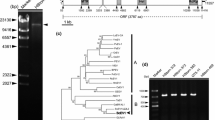Abstract
Rhizoctonia solani endornavirus 8 (RsEV8) was isolated from strain XY175 of Rhizoctonia solani AG-1 IA. The full-length genome of RsEV8 is 16,147 nucleotides (nt) in length and contains a single open reading frame that encodes a large polyprotein of 5227 amino acids. The polyprotein contains four conserved domains: viral methyltransferase, putative DEAH box helicase, viral helicase, and RNA-dependent RNA polymerase (RdRp). RsEV8 has a shorter 3'-UTR (58 nt) and a longer 5'-UTR (404 nt). A multiple sequence alignment indicated that the RdRp of RsEV8 possesses eight typical RdRp motifs. According to a BLASTp analysis, RsEV8 shares 39.31% sequence identity with Rhizoctonia cerealis endornavirus-1084-7. Phylogenetic analysis demonstrated that RsEV8 clusters with members of the genus Betaendornavirus.


Similar content being viewed by others
Data availability
All relevant data are within the paper.
References
Lefebvre A, Scalla R, Pfeiffer P (1990) The double-stranded RNA associated with the “447” cytoplasmic male sterility in Vicia faba is packaged together with its replicase in cytoplasmic membranous vesicles. Plant Mol Biol 14:477–490
Valverde RA, Khalifa ME, Okada R, Fukuhara T, Sabanadzovic S, Ictv Report C (2019) ICTV virus taxonomy profile: Endornaviridae. J Gen Virol 100:1204–1205
Fukuhara T (2019) Endornaviruses: persistent dsRNA viruses with symbiotic properties in diverse eukaryotes. Virus Genes 55:165–173
Roossinck MJ, Sabanadzovic S, Okada R, Valverde RA (2011) The remarkable evolutionary history of endornaviruses. J Gen Virol 92:2674–2678
Li W, Zhang H, Shu Y, Cao S, Sun H, Zhang A, Chen H (2021) Genome structure and diversity of novel endornaviruses from wheat sharp eyespot pathogen Rhizoctonia cerealis. Virus Res 297:198368
Okada R, Yong CK, Valverde RA, Sabanadzovic S, Aoki N, Hotate S, Kiyota E, Moriyama H, Fukuhara T (2013) Molecular characterization of two evolutionarily distinct endornaviruses co-infecting common bean (Phaseolus vulgaris). J Gen Virol 94:220–229
Ong JWL, Li H, Sivasithamparam K, Dixon KW, Jones MGK, Wylie SJ (2016) Novel Endorna-like viruses, including three with two open reading frames, challenge the membership criteria and taxonomy of the Endornaviridae. Virology 499:203–211
Osaki H, Nakamura H, Sasaki A, Matsumoto N, Yoshida K (2006) An endornavirus from a hypovirulent strain of the violet root rot fungus, Helicobasidium mompa. Virus Res 118:143–149
Tuomivirta TT, Kaitera J, Hantula J (2009) A novel putative virus of Gremmeniella abietina type B (Ascomycota: Helotiaceae) has a composite genome with endornavirus affinities. J Gen Virol 90:2299–2305
Khankhum S, Valverde RA (2018) Physiological traits of endornavirus-infected and endornavirus-free common bean (Phaseolus vulgaris) cv Black Turtle Soup. Arch Virol 163:1051–1056
Otulak-Kozieł K, Kozieł E, Escalante C, Valverde RA (2020) Ultrastructural analysis of cells from bell pepper (Capsicum annuum) infected with bell pepper endornavirus. Front Plant Sci 11:491
Yang D, Wu M, Zhang J, Chen W, Li G, Yang L (2018) Sclerotinia minor endornavirus 1, a novel pathogenicity debilitation-associated mycovirus with a wide spectrum of horizontal transmissibility. Viruses 10:589
Luo X, Jiang D, Xie J, Jia J, Duan J, Cheng J, Fu Y, Chen T, Yu X, Li B, Lin Y (2022) Genome characterization and phylogenetic analysis of a novel endornavirus that infects fungal pathogen Sclerotinia sclerotiorum. Viruses 14:456
Bernardes-de-Assis J, Storari M, Zala M, Wang W, Jiang D, Shidong L, Jin M, McDonald BA, Ceresini PC (2009) Genetic structure of populations of the rice-infecting pathogen Rhizoctonia solani AG-1 IA from China. Phytopathology 99:1090–1099
Bhaskar Rao T, Chopperla R, Prathi NB, Balakrishnan M, Prakasam V, Laha GS, Balachandran SM, Mangrauthia SK (2020) A comprehensive gene expression profile of pectin degradation enzymes reveals the molecular events during cell wall degradation and pathogenesis of rice sheath blight pathogen Rhizoctonia solani AG1-IA. J Fungi 6:71
González-Vera AD, Bernardes-de-Assis J, Zala M, McDonald BA, Correa-Victoria F, Graterol-Matute EJ, Ceresini PC (2010) Divergence between sympatric rice- and maize-infecting populations of Rhizoctonia solani AG-1 IA from Latin America. Phytopathology 100:172–182
Gónzalez D, Rodriguez-Carres M, Boekhout T, Stalpers J, Kuramae EE, Nakatani AK, Vilgalys R, Cubeta MA (2016) Phylogenetic relationships of Rhizoctonia fungi within the Cantharellales. Fungal Biol 120:603–619
Jia Y (2010) Cytological and molecular characterization of rice sheath blight pathogen Rhizoctonia Solani. Eur J Plant Pathol 129:511–528
Singh P, Mazumdar P, Harikrishna JA, Babu S (2019) Sheath blight of rice: a review and identification of priorities for future research. Planta 250:1387–1407
Abdoulaye AH, Foda MF, Kotta-Loizou I (2019) Viruses infecting the plant pathogenic fungus Rhizoctonia solani. Viruses 11:1113
Picarelli MASC, Forgia M, Rivas EB, Nerva L, Chiapello M, Turina M, Colariccio A (2019) Extreme diversity of mycoviruses present in isolates of Rhizoctonia solani AG2-2 LP from Zoysia japonica from Brazil. Front Cell Infect Microbiol 9:244
Li Y, Chen W, Niu Y, Xu P, Zhang L, Yu S, Yang G, Mo X (2022) Complete nucleotide sequence of a novel alphapartitivirus from Rhizoctonia solani AG-4 HG III isolate SM03. Arch Virol 167:953–957
Abdoulaye AH, Hai D, Tang Q, Jiang D, Fu Y, Cheng J, Lin Y, Li B, Kotta-Loizou I, Xie J (2021) Two distant helicases in one mycovirus: evidence of horizontal gene transfer between mycoviruses, coronaviruses and other nidoviruses. Virus Evol 7:043
Das S, Falloon RE, Stewart A, Pitman AR (2014) Molecular characterisation of an endornavirus from Rhizoctonia solani AG-3PT infecting potato. Fungal Biol 118:924–934
Zheng L, Shu CW, Zhang ML, Yang M, Zhou EX (2019) Molecular characterization of a novel endornavirus conferring hypovirulence in rice sheath blight fungus Rhizoctonia solani AG-1 IA Strain GD-2. Viruses-Basel 11:178
Das S, Falloon RE, Stewart A, Pitman AR (2016) Novel mitoviruses in Rhizoctonia solani AG-3PT infecting potato. Fungal Biol 120:338–350
Bartholomäus A, Wibberg D, Winkler A, Pühler A, Schlüter A, Varrelmann M (2016) Deep sequencing analysis reveals the mycoviral diversity of the virome of an avirulent isolate of Rhizoctonia solani AG-2-2 IV. PLoS One 11:e0165965
Li Y, Lyu R, Hai D, Jia J, Jiang D, Fu Y, Cheng J, Lin Y, Xie J (2022) Two novel rhabdoviruses related to hypervirulence in a phytopathogenic fungus. J Virol 96:e0001222
Potgieter AC, Page NA, Liebenberg J, Wright IM, Landt O, van Dijk AA (2009) Improved strategies for sequence-independent amplification and sequencing of viral double-stranded RNA genomes. J Gen Virol 90:1423–1432
Acknowledgments
This work was financially supported by the Fundamental Research Funds for the Central Universities (grant 2021ZKPY005), the National Key Research and Development Program of China (grant 2017YFD0201100), and the Natural Science Foundation of China (grant 31772111).
Funding
This work was supported by Natural Science Foundation of China with grant 31772111.
Author information
Authors and Affiliations
Corresponding author
Ethics declarations
Conflict of interest
The authors declare that they have no conflict of interest.
Ethical approval
This research did not use human participants or other animals.
Additional information
Handling Editor: Nobuhiro Suzuki.
Publisher's Note
Springer Nature remains neutral with regard to jurisdictional claims in published maps and institutional affiliations.
Rights and permissions
Springer Nature or its licensor (e.g. a society or other partner) holds exclusive rights to this article under a publishing agreement with the author(s) or other rightsholder(s); author self-archiving of the accepted manuscript version of this article is solely governed by the terms of such publishing agreement and applicable law.
About this article
Cite this article
Li, Y., Huang, X., Zhou, G. et al. Characterization of a novel endornavirus isolated from the phytopathogenic fungus Rhizoctonia solani. Arch Virol 169, 15 (2024). https://doi.org/10.1007/s00705-023-05915-2
Received:
Accepted:
Published:
DOI: https://doi.org/10.1007/s00705-023-05915-2




